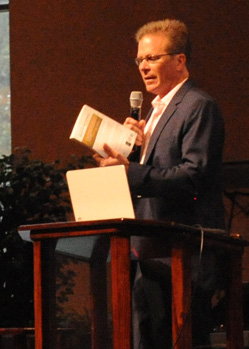National Apologetics Conference, Charlotte, NCOctober 9-11, 2014The National Apologetics Conference has been sponsored by Southern Evangelical Seminary of Charlotte for 21 years. This year it was held in this dramatic large church in the south suburbs of Charlotte. Calvary Church features a 5000 seat sanctuary and has a multi-faceted ministry. You have to dig to find out that its original affiliation is Presbyterian because it emphasizes the community church stance. The present facility dates to 1989 but added the large Calvary Life Center in 2012. |  |
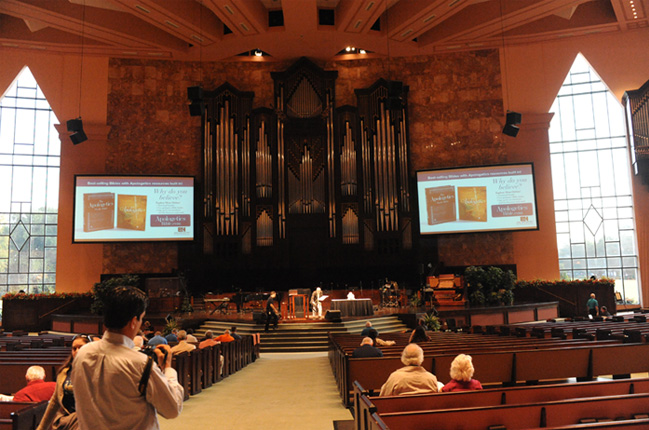 | We arrived in Charlotte on Thursday afternoon, October 9, and drove to the huge Calvary Church in south Charlotte. We explored the church a bit, including the sanctuary and majestic pipe organ. We had a wonderful dinner at the Waldhorn Restaurant and then went to the Southern Evangelical Seminary campus for Brenda to attend a session of the Women's Conference being held there. |
| On Friday morning we arrived early at Calvary and caught up with Colin and Tracy Green for the first session of the Apologetics Conference. |  |
 | We started the day with an address by Michael Behe on "The Edge of Evolution: The Search for the Limits of Darwinism". It was an excellent presentation, using the example of Malaria following the content of his book "The Edge of Evolution". I had read both it and his "Darwin's Black Box", so I was thoroughly familiar with the material he presented. |
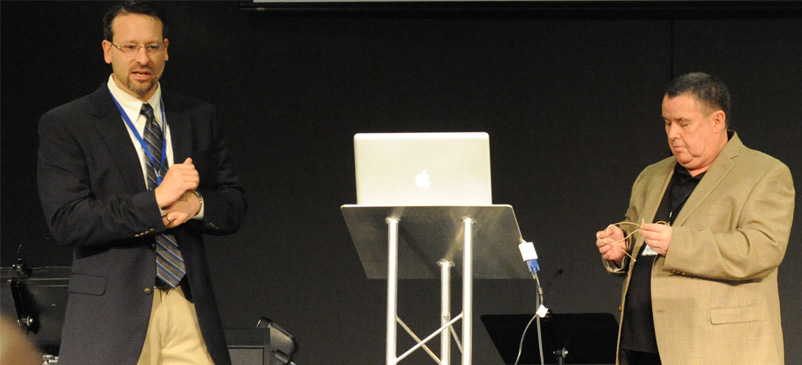
J. Thomas Bridges and Ken Samples did a joint presentation on "Why Science Needs Philosophy", and I thought it was one of the most outstanding things I heard at the conference. I had heard Ken speak on several occasions, had read his book "A World of Difference", and had talked with him on the Alaska Cruise, but he still surprised me with his eloquence on this topic. I didn't know Bridges, but was very much impressed with his insights - they worked extremely well together.
Dr. Bridges has a Ph.D. from Southern Evangelical Seminary in the philosophy of religion, a B.S. from Iowa State University, a M. Div. from Southwestern Baptist Theological Seminary, and a M.A. in Philosophy from Baylor University. His academic interests include Intelligent Design, the Problem of Evil, and the philosophical theology of St. Thomas Aquinas.
Dr. Bridges teaches graduate level philosophy classes including Epistemology, Metaphysics, Symbolic Logic and the History of Modern and Contemporary Philosophy.
 J. Warner Wallace presented on "Alive: A Cold-Case Approach to the Resurrection". I had never heard him before, and learned a lot. | Hugh Ross took on the topic "Noah's Flood: Global or Worldwide?". He did an excellent job, and has become a master at making beautiful and informative slides with Keynote. I had read all his material in his books, so there were no surprises. 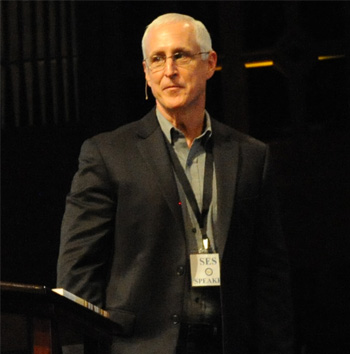 |
I went to a session by John Ferrer on "Nature's Aims: Why Scientists Can't Get Rid of Teleology". John Ferrer is an educator with Pantego Christian Academy, Tarrant Count College and Texas Wesleyan University. He has a BA in Religion from Charleston Southern University; an MDiv in Apologetics from Southern Evangelical Seminary; a ThM from Southwestern Baptist Theological Seminary; and is finishing up his Ph. D. there in the same field. John has participated in formal debates and panel discussions addressing theism and Christian worldview at Texas A&M, UT Arlington, UT Dallas, and Collin County Community College.
He also directs a Ratio Christi chapter at Dallas Baptist University. John currently teaches classes in apologetics, world religions, and Old Testament.
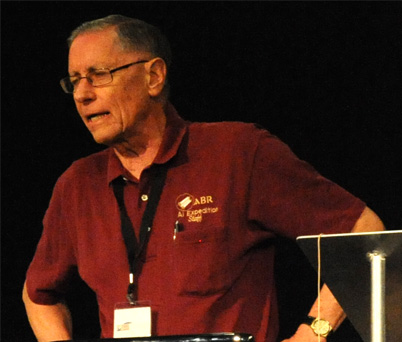 | Dr. Bryant Wood addressed the topic "The Walls of Jericho: Did they REALLY Come Tumblin' Down?". I had been looking forward to hearing him since I had heard Ted Wright speak to Areopagus; he had recommended Bryant Wood as the outstanding scholar on this era of Biblical archaeology. 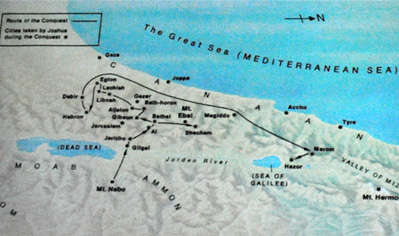 |
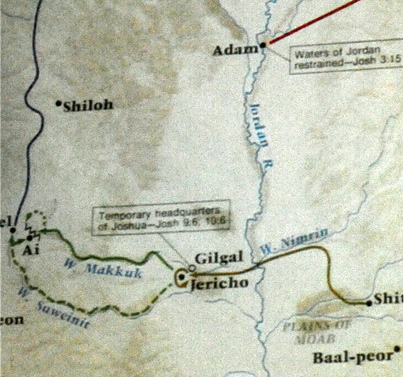 I was certainly not disappointed - Bryant knew this subject like the back of his hand. He showed us the position of Jericho relative to Adan, where large cliffs could fall off and block the Jordan. | 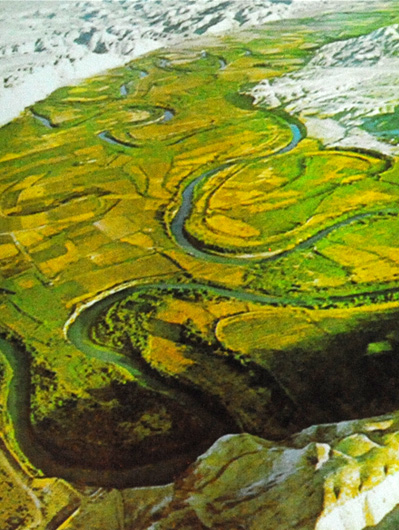 |
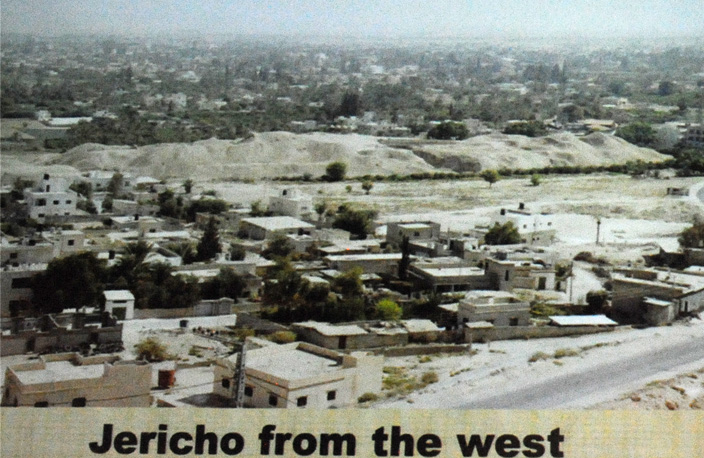 | A view of modern Jericho shows the mound which contains the ruins of Biblical Jericho as well as other cities layered with it. This mound has the formal name Tel Es-Sultan. |
 | 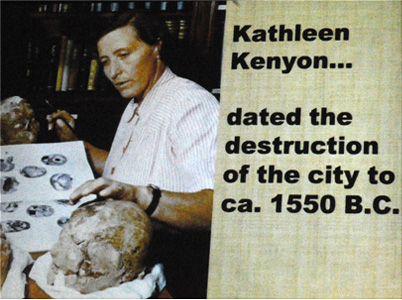 |
These are two prominent characters in the story of the excavation of Jericho. John Garstang got a date of about 1400BC, in good agreement with the best reckoning from the Bible of 1406BC. But Kathryn Kenyon in a later excavation dated it at 1550 BC.
 | Sketch of the three main excavations of the Jericho mound. |
| Model of the city of Jericho. Bryant favored the Biblical date of 1406, consistent with the pottery dating he had done. | 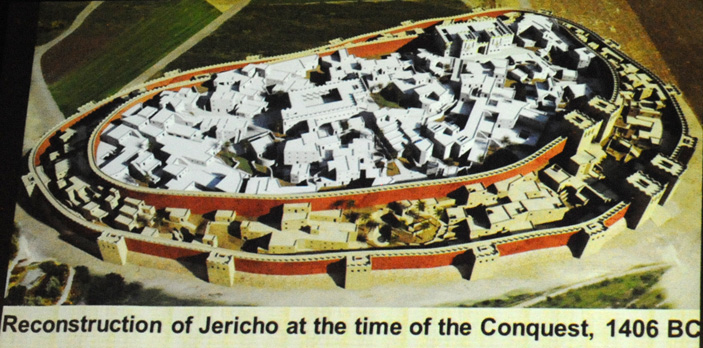 |
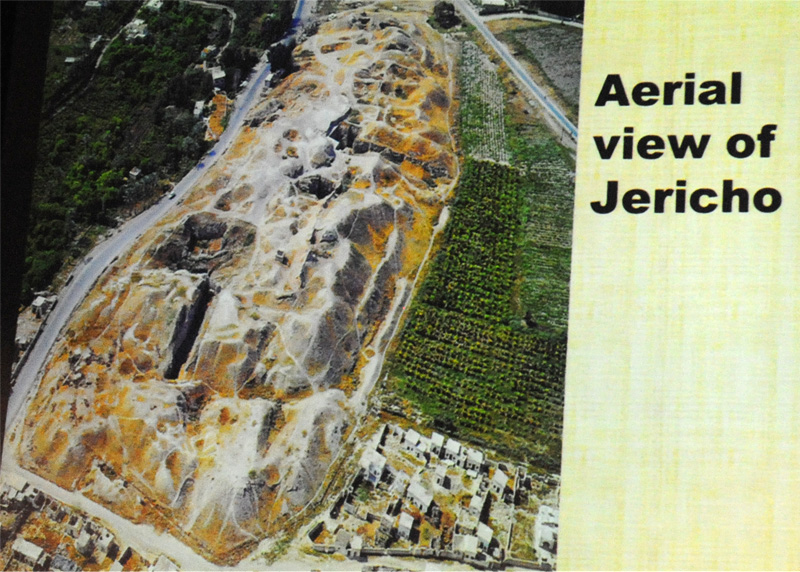
 | This schematic of the walls of the city of Jericho shows how formidable they would be to any assault on foot. |
This picture of Bryant Wood standing by the retaining wall below the two walls themselves makes the setting seem even more impossible for the attacking Israelites. | 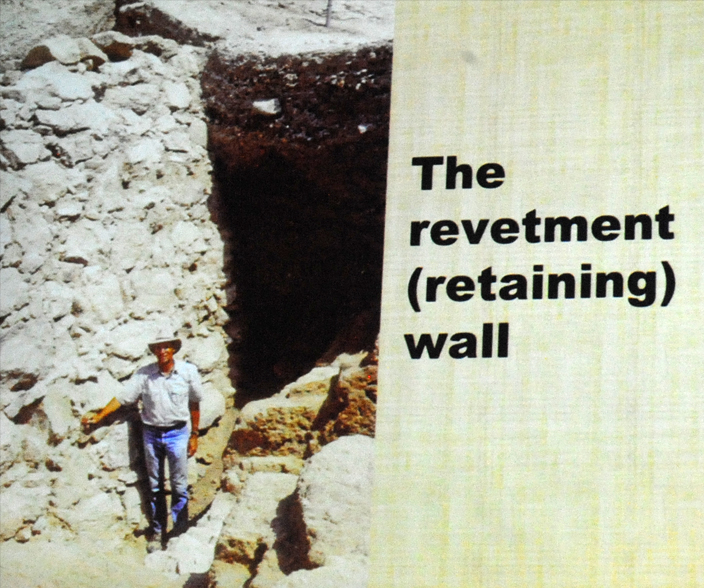 |
 | My understanding here is that the retaining wall is shown to be excavated to the bedrock on which it sits. This apparently shows that the building of Jericho displaced an even earlier Caananite city, the ruins of which are shown here. The outer Jericho wall was above the retaining wall. |
This cross section of the wall shows in red the fallen bricks of the Jericho wall. They fell outward, making a ramp up the high retaining wall shown in images above. |  |
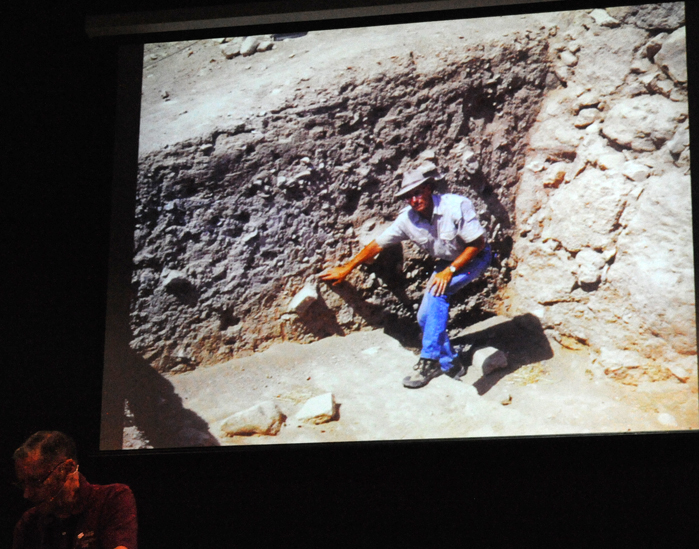 | Bryant Wood shows a picture of himself with a hand on one of the bricks of the Jericho wall. This is in the excavation of the brick debris from the fall of the wall, showing its cross section leading to the retaining wall. |
Of great interest is the story of Rahab, who is said to have lived in or on the wall. This view of the ruins shows how that could have been so at the point that is labeled "Mudbrick Wall". | 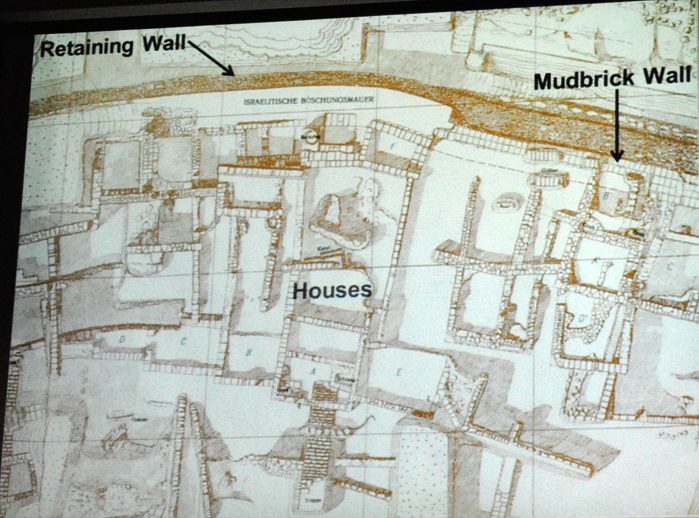 |
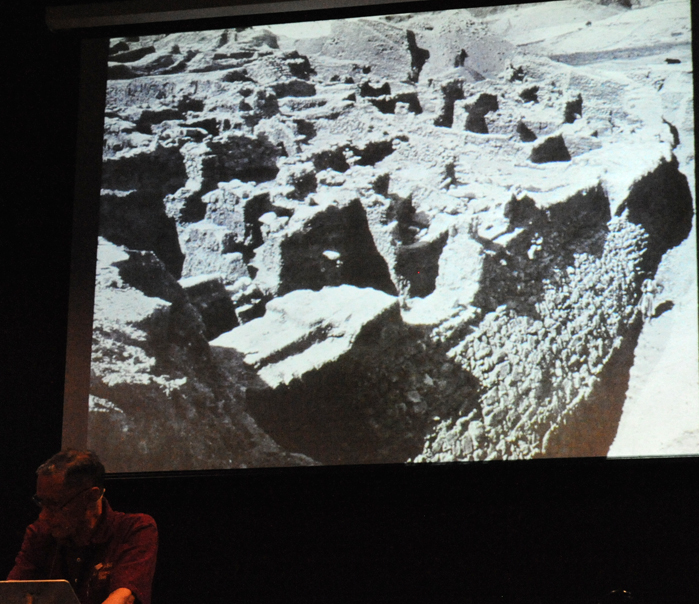 | This view of ruins also shows the dwellings right up to the wall. |
An artist's conception of how Rahab could have had a house with a window in the wall from which she could have let down a basket. | 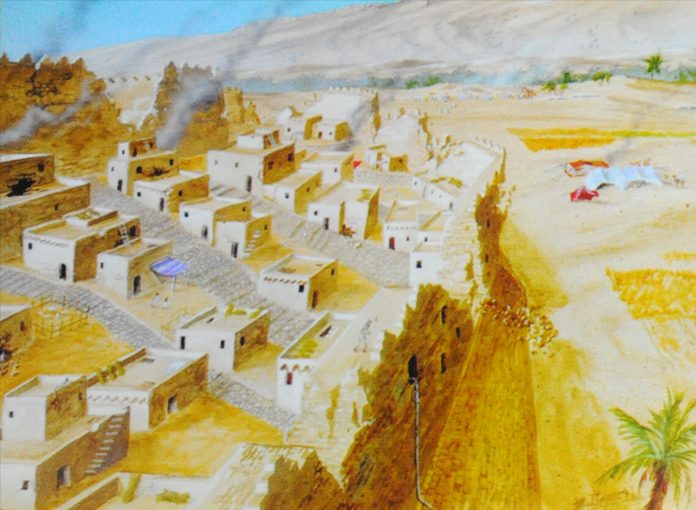 |
 | Another conception of the house in the wall. This one has the sheaves of flax which note that it is in the spring harvest season for the flax. |
A cross-section view showing the proposed identification and dates of different parts of the excavation. |  |
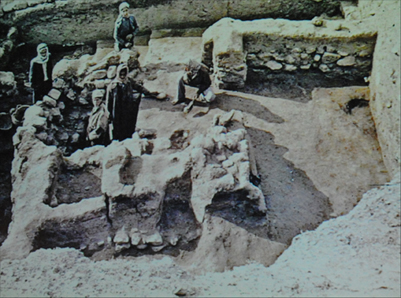 | 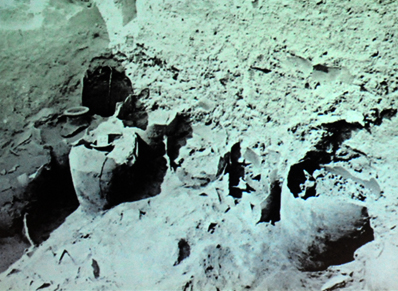 |
The excavation of the dwellings was a fascinating part of the story. They found grain jars from the harvest that were full of grain, but grain that had been burned by a fire that swept over the city. All of this is congruent with the Biblical story. It was spring flood stage, just after the harvest, when the Israelites crossed, and the conquest of Jericho was soon afterward - as soon as a week. It was suggested that the stopping of the Jordan was by an earthquake that dropped one of the cliffs into the Jordan at Adam upstream, and that an aftershock contributed to the fall of the walls of Jericho.
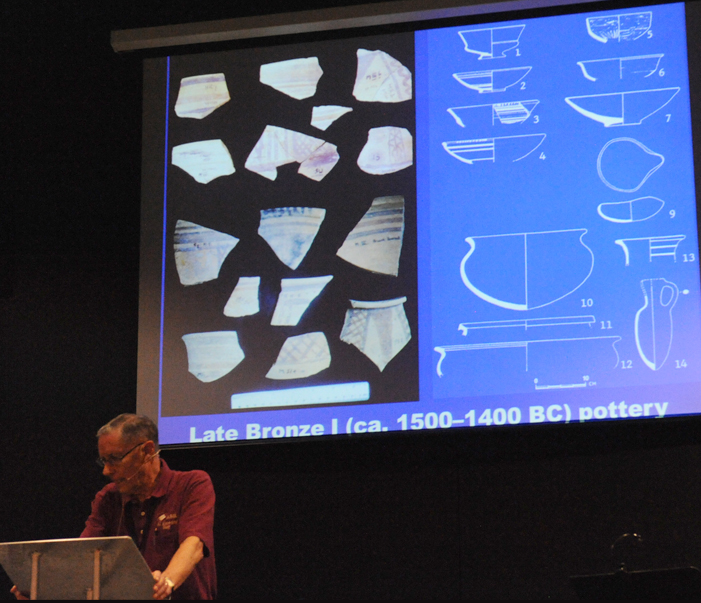 | One of Dr. Bryant Wood's particular contributions to the archaeology of the Biblical sites is his work in using pottery to date the finds. Ted Wright in his Areopagus presentation in Atlanta in the spring paid tribute to Dr. Wood for his outstanding contributions to Biblical archaeology, and both he and Dr. Wood find fault with Kenyon's dating of the site to about 1500 on the grounds that the pottery suggests a later date. |
Bryant Wood was low-key and softly-spoken, but he wove a fascinating tale of Jericho, and as far as factual information goes, I learned more from his presentation than any other.
One final aerial view of the mound which was ancient Jericho in its modern setting of orchards and farmlands in the West Bank of Palestine. From all of this you will know that I found this story of Jericho fascinating. |  |
October 11, 2014

It was a privilege to start the day listening to Walter Kaiser, one of the old masters in Old Testament studies. His topic was "The Old Testament Documents: Are They Reliable and Relevant?" He focused on the book of Esther, but brought in a lot of other material about the Old Testament.
KaiserŐs interest in the Old Testament was first sparked by a high school biology class in which the Genesis account was kindly, but firmly, debunked. When Kaiser dared to voice another opinion, he was challenged to do a report that would convince his teacher otherwise. Undaunted, Kaiser prepared a forty-page paper complete with anthropological drawings and bibliography.
After graduating from Wheaton Graduate School in 1958, Kaiser taught full-time at Wheaton College. During the summer months he pursued further graduate studies in Old Testament and ancient history at Brandeis University, where his mentors included Benjamin Mazar, Samuel Noah Kramer, Harry Orlinsky, and Cyrus H. Gordon. His course of study at Brandeis included Middle and Late Egyptian hieroglyphics, Ugaritic, Homeric Greek, biblical Hebrew, Old Babylonian cuneiform, Assyrian cuneiform, and the history and archeology of the ancient Near Eastern empires.
Kaiser retired from the presidency of Gordon-Conwell on July 1, 2006. Currently he is President Emeritus and Distinguished Professor of Old Testament and Ethics at Gordon-Conwell Theological Seminary in Hamilton, MA.
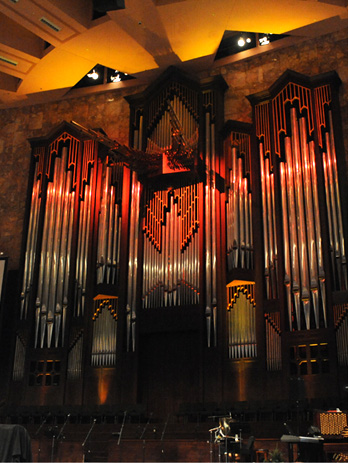
| For the midmorning session we returned to the huge sanctuary with its impressive pipe organ and its huge lighted cross overhead.  J. Warner Wallace addresses "Cold-Case Christianty: A Homicide Detective Investigates the Claims of the Gospels"  |
 | Wallace talked to us about developing evidence, and about the "chain of custody" of the evidence. Luke can be placed before the martyrdom of James and Paul and before the destruction of the temple since they are not mentioned. |
Early church fathers Ignatius, Papias and Polycarp had writings that were consistent with the teaching of the apostles and began to collect books that were considered to be scripture. | 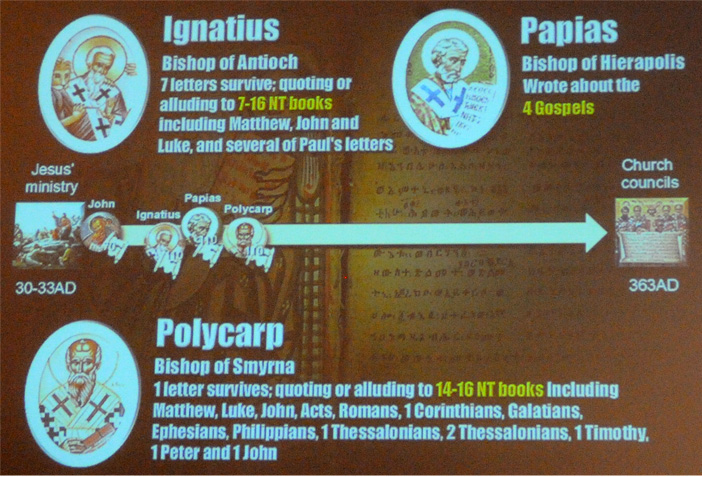 |
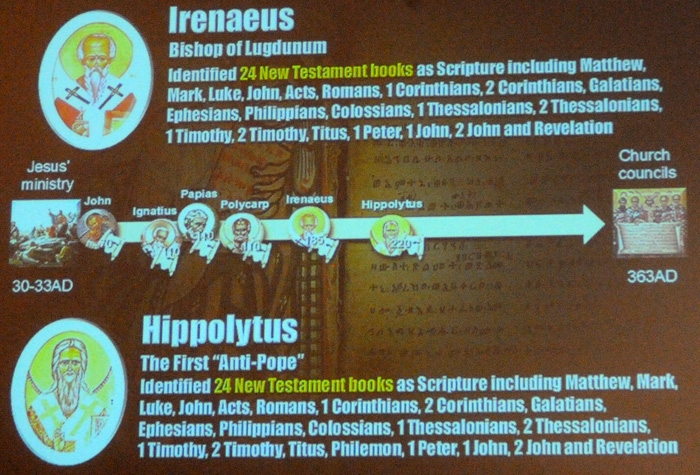 | Early church fathers Irenaeus and Hippolytus had lists of New Testament books that were accepted as scripture, as being "apostolic". |
Peter, John and Paul and their students had writings that were independent but consistent, bridging a substantial amount of the time between Jesus' ministry and the Councils which established the New Testament canon. | 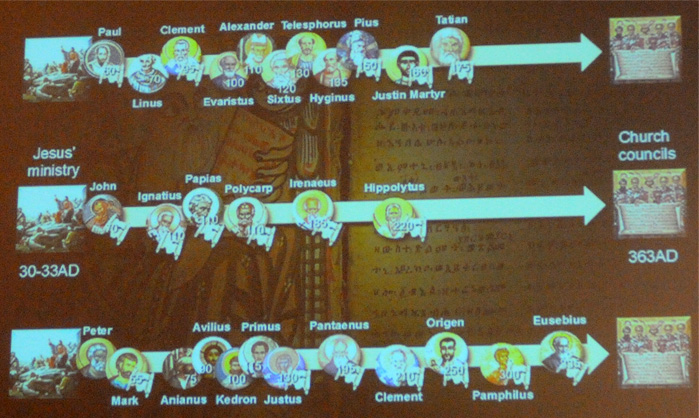 |
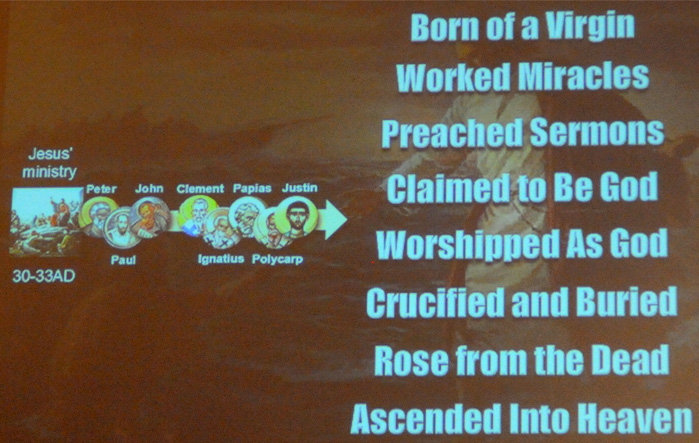 | Paul, Peter and John and their disciples and students consistently confirmed the elements of the early Christian faith. |
Warner gave Bart Ehrman a hard time about his "Misquoting Jesus" and extravagant claims about inconsistencies in the New Testament. He actually turned that around to point out that the comparison of numerous copies with small discrepancies can actually strengthen your case that you have the essence of the original. He compared the large number of early copies of the New Testament with the small number of late copies of Josephus. | 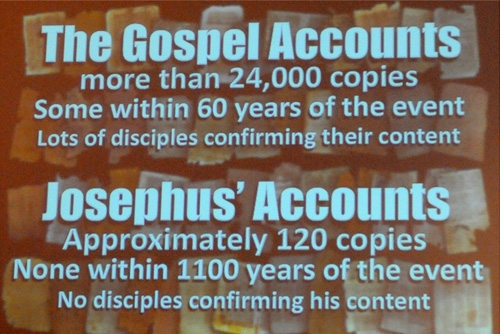 |
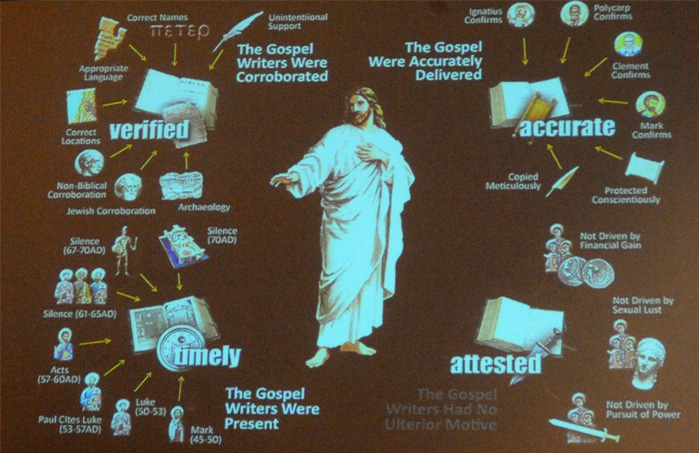 | He had an impressive sequence of slides showing that the four standard types of evidence were present to defend the historical Jesus. |
Dr. Hugh Ross did an afternoon session titled "Beyond the Cosmos", discussing the beginning of the universe, the space-time equations, Bord-Guth-Vilenkin, evidence for a Creator outside space and time, his model of a second time dimension for God's action, and comments on multiple dimensions. His presentation was very polished and he had beautiful slides. It was all familiar material to me since I have read all his books. |  |
 | A musical group led us in an afternoon worship session in the dramatic sanctuary. I was glad to get to hear the dramatic pipe organ. |
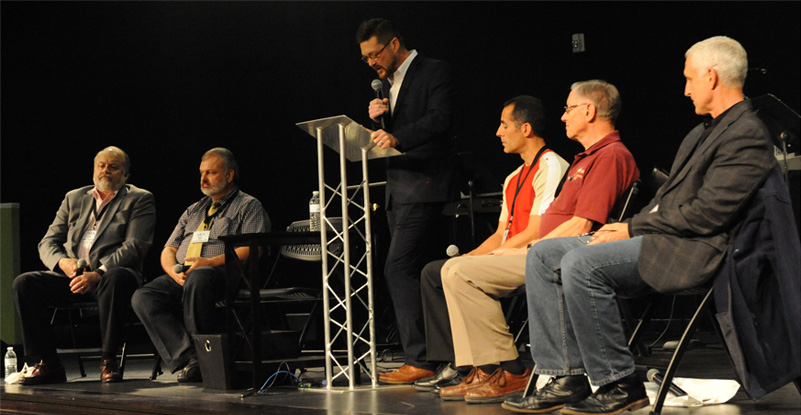
A panel discussion titled "Investigating the Historical Jesus" featuring Dr. Gary Habermas, Dr. Joseph Bergeron, Ted Wright (moderator), Allan Di Donato, Dr. Bryant Wood, and J. Warner Wallace.
J. Warner Wallace commenting on the nature of the evidence for the historical Jesus. The panel affirmed the strength of the evidence for the truth of the gospels based on the gospels and the writings of Paul, particularly 1 Corinthians and Galatians which were very early. Gary Habermas commented on 1 Corinthians 15 and Galatians 1 as being so strong that most critics of the Bible conceded them. |  |
While there is little writing before about 50AD, there is lots of evidence that the writing then contained creeds and songs which are from very soon after the crucifixion.
Another historical strength is the fact that the writings of the students of Peter, Mark and John are consistent with the Bible. Also powerful is the fact that none of the disciples turned away or changed their story, even though all but John suffered martyrs deaths for their beliefs. Wallace contrasted this with Mormonism where the three main students of Joseph Smith all turned away.
Dr. Gary Habermas is the Distinguished Research Professor and Chair of the Department of Philosophy and Theology at Liberty University. He has published 36 books (18 on the subject of Jesus' resurrection). He has also published more than sixty chapters or articles in other books, plus more than 100 articles in journals and other periodicals. During the past ten years or so, he has been a Visiting or Adjunct Professor, teaching dozens of courses at 15 different graduate schools and seminaries in the US and abroad.
Joseph W. Bergeron, M.D., is a specialist in Physical Medicine and Rehabilitation. He has authored a review and analysis of medical hypotheses for Jesus' cause of death published in the Journal of Forensic and Legal Medicine.Dr. Bergeron and Dr. Gary Habermas have recently collaborated on a critique of hallucination hypotheses for the Biblical story of Easter published in the Irish Theological Quarterly. Dr. Bergeron lectures in churches and college campuses using his peer reviewed published work as a basis for apologetic discussion.
Dr. Bergeron's medical practice is dedicated to treating neuromuscular disease and injury, including determination of injury causation and associated impairments or disability. In addition to medical practice, Dr. Bergeron has worked in Christian ministry and has participated in numerous medical and short term mission trips, including trips to Mexico, India, Kenya, and Ethiopia. He lives with his wife and children in Indianapolis, Indiana.
Ted W. Wright serves as the Executive Director of CrossExamined.org, a Christian apologetics ministry founded by best selling author and speaker, Dr. Frank Turek. Ted is a speaker on Christian apologetics as well as Biblical Archaeology across North America & internationally. In addition to speaking, Ted has also appeared on numerous television and radio programs including the History Channel's epic TV miniseries - "Mankind: The Story of All of Us." In addition, he also serves as adjunct professor of apologetics at Southern Evangelical Seminary located in Charlotte, NC where he has taught for over a decade. Ted has a B.A. in anthropology & archaeology from the Cobb Institute of Archaeology at Mississippi State University. As a student he served as a curation lab assistant on Phase III (1992-1999) of the Lahav Research Project from Tel Halif, organized by Dr. Joe D. Seger of the Cobb Institute and assisted by the W. F. Albright Institute of Archaeological Research and the Nelson Glueck School of Biblical Archaeology, and from the Joe Alon Center for Regional and Folklore Studies at Kibbutz Lahav. Ted also serves as a professional associate for the Associates for Biblical Research. This summer he participated in excavations at Khirbet el-Maqatir (Joshua's Ai) located in the West Bank in Israel - a dig sponsored by ABR.
Ted has an M.A. in Christian apologetics with a concentration in philosophy from Southern Evangelical Seminary.
Allan Di Donato earned his B.A. in the Classics, an M.A. in Classical Archeology, and is currently pursuing an M.A. in Philosophy in Southern Evangelical Seminary. Currently, Allan is an Instructor of Humanities and Philosophy at Central Piedmont Community College, where he teaches courses in Myth and Human Culture, Ancient and Medieval Humanities, and Logic.
Dr. Bryant Wood received international media attention for his research on ancient Jericho that demonstrated the historicity of the Biblical account of the capture of the city by the Israelites. Dr. Wood is a specialist in Canaanite pottery of the Late Bronze Age. He is author of "The Sociology of Pottery in Ancient Palestine: The Ceramic Industry and the Diffusion of Ceramic Style in the Bronze and Iron Ages (1990)," as well as, numerous articles on archaeological subjects published in various academic journals.
Dr. Wood has been awarded grants from the National Endowment for the Humanities, the Endowment for Biblical Research and the national Science Foundation to carry on his archaelogical research. He is on the Board of Directors of the Near East Archaelogical Society and is a Fellow of the Institute for Biblical Research. He is Director of Research with Associates for Biblical Research, and founder and Consulting Editor of the Bible and Spade magazine. Dr. Wood and his wife Faith reside in Manheim, PA.
J. Warner Wallace is a cold-case homicide detective, a Christian case maker and an author. Jim was a conscientious and vocal atheist through his undergraduate and graduate work in Design and Architecture (CSULB and UCLA); he always considered himself to be an "evidentialist." His experience in law enforcement only served to strengthen his conviction that truth is tied directly to evidence. But at the age of thirty-five, J. Warner took a serious and expansive look at the evidence for the Christian Worldview and determined that Christianity was demonstrably true. After becoming a Christ follower in 1996, Jim continued to take an evidential approach to truth as he examined the Christian worldview. He eventually earned a Master's Degree in Theological Studies from Golden Gate Baptist Theological Seminary.
J. Warner served as a Youth Pastor for several years, then planted a church in 2006. Along the way, he created and built the PleaseConvinceMe.com website, blog and podcast as a place to post and talk about what he discovered related to the evidence supporting Christianity. This adventure in Christian case making has become the major thrust of Jim's volunteer service at Stand to Reason, where he is an adjunct speaker and contributor. Jim has appeared on television and radio, explaining the role that evidence plays in the Christian definition of "faith" and defending the historicity of Jesus, the reliability of the Bible and the truth of the Christian worldview. Jim also speaks at churches, retreats and camps as he seeks to help people become confident Christian case makers.
| Georgia Tech BSU gathering at Bonds' |
2014
